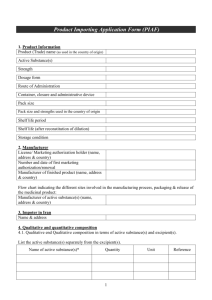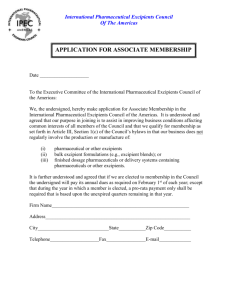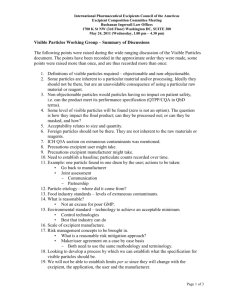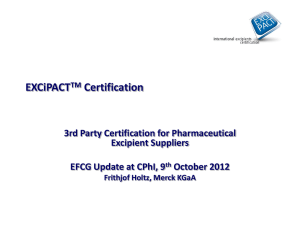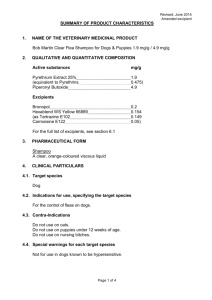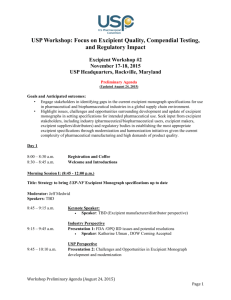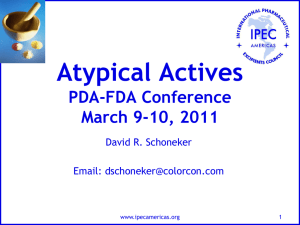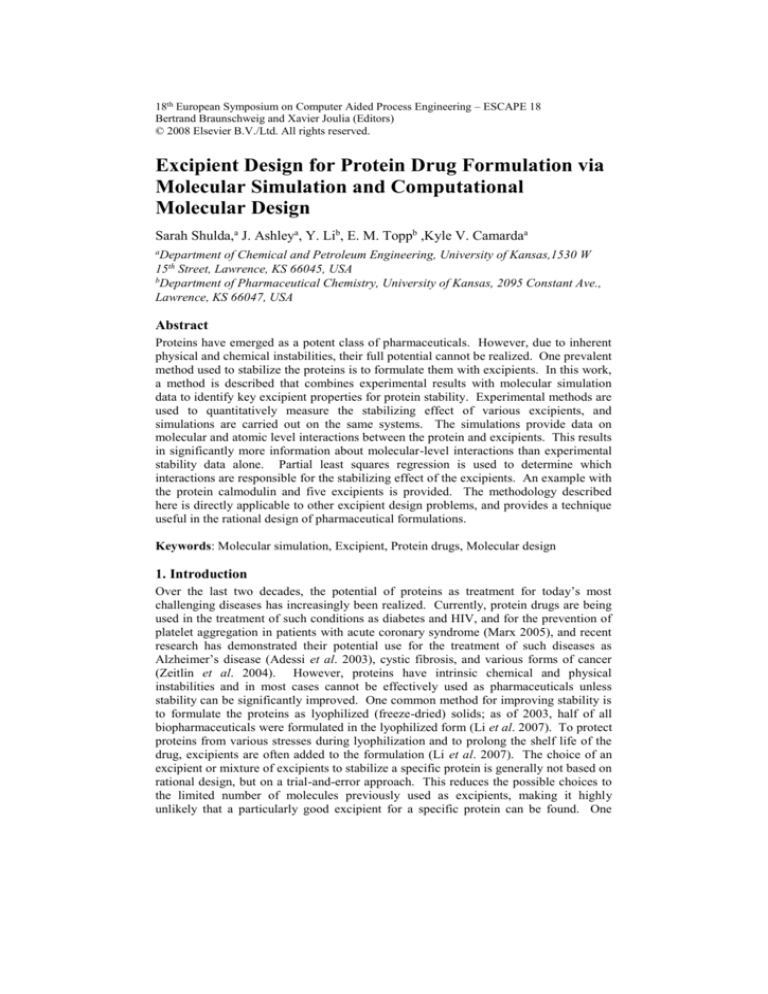
18th European Symposium on Computer Aided Process Engineering – ESCAPE 18
Bertrand Braunschweig and Xavier Joulia (Editors)
© 2008 Elsevier B.V./Ltd. All rights reserved.
Excipient Design for Protein Drug Formulation via
Molecular Simulation and Computational
Molecular Design
Sarah Shulda,a J. Ashleya, Y. Lib, E. M. Toppb ,Kyle V. Camardaa
a
Department of Chemical and Petroleum Engineering, University of Kansas,1530 W
15th Street, Lawrence, KS 66045, USA
b
Department of Pharmaceutical Chemistry, University of Kansas, 2095 Constant Ave.,
Lawrence, KS 66047, USA
Abstract
Proteins have emerged as a potent class of pharmaceuticals. However, due to inherent
physical and chemical instabilities, their full potential cannot be realized. One prevalent
method used to stabilize the proteins is to formulate them with excipients. In this work,
a method is described that combines experimental results with molecular simulation
data to identify key excipient properties for protein stability. Experimental methods are
used to quantitatively measure the stabilizing effect of various excipients, and
simulations are carried out on the same systems. The simulations provide data on
molecular and atomic level interactions between the protein and excipients. This results
in significantly more information about molecular-level interactions than experimental
stability data alone. Partial least squares regression is used to determine which
interactions are responsible for the stabilizing effect of the excipients. An example with
the protein calmodulin and five excipients is provided. The methodology described
here is directly applicable to other excipient design problems, and provides a technique
useful in the rational design of pharmaceutical formulations.
Keywords: Molecular simulation, Excipient, Protein drugs, Molecular design
1. Introduction
Over the last two decades, the potential of proteins as treatment for today’s most
challenging diseases has increasingly been realized. Currently, protein drugs are being
used in the treatment of such conditions as diabetes and HIV, and for the prevention of
platelet aggregation in patients with acute coronary syndrome (Marx 2005), and recent
research has demonstrated their potential use for the treatment of such diseases as
Alzheimer’s disease (Adessi et al. 2003), cystic fibrosis, and various forms of cancer
(Zeitlin et al. 2004). However, proteins have intrinsic chemical and physical
instabilities and in most cases cannot be effectively used as pharmaceuticals unless
stability can be significantly improved. One common method for improving stability is
to formulate the proteins as lyophilized (freeze-dried) solids; as of 2003, half of all
biopharmaceuticals were formulated in the lyophilized form (Li et al. 2007). To protect
proteins from various stresses during lyophilization and to prolong the shelf life of the
drug, excipients are often added to the formulation (Li et al. 2007). The choice of an
excipient or mixture of excipients to stabilize a specific protein is generally not based on
rational design, but on a trial-and-error approach. This reduces the possible choices to
the limited number of molecules previously used as excipients, making it highly
unlikely that a particularly good excipient for a specific protein can be found. One
2
S. Shulda, K. Camarda
substantial barrier to excipient design has been the large number of factors that could
potentially contribute to protein degradation and stabilization. Sorting through these
possible variables using experimental techniques alone would require an unreasonable
number of excipients to be analyzed and detailed experiments to be carried out on each
excipient. Furthermore, since it is difficult to analyze specific molecular level
interactions using experimental methods, it may be impossible to determine the
important variables regardless of the resources available.
In this work, an unbiased and systematic method for determining the variables
critical to stability is developed. Experimental results from excipient stability studies
are combined with data from molecular simulations to develop a predictive model
relating excipient activity to specific interactions between the excipient and protein.
The resulting model serves several important purposes: it provides valuable insight into
the mechanisms through which an excipient acts to stabilize a protein, and uncovers the
excipient properties responsible for protein stability, both of which are necessary for
rational design. Since the model can be used to predict the activity of excipients not
initially used in its development, this methodology may be easily applied to
computational molecular design studies, in which an optimization approach is used to
search through a set of potential candidates to find those molecules most closely
matching a set of property targets (Chavali et al. 2004; Karunanithi et al. 2005; Eslick et
al. 2006).
2. Methods
Detailed below is a new methodology developed in this work to combine experimental
results with simulation data to develop a model relating the stabilizing activity of an
excipient to specific excipient properties and important interactions between the
excipient and the protein.
2.1. Experimental
An experimental method to quantitatively analyze the stabilizing effect of excipients on
proteins, known as hydrogen-deuterium (H/D) exchange (Li et al. 2007), is employed
here to be paired with simulation studies. The protein is formulated in solution with
various excipients, which are chosen to span a range of excipient structures, including
various charges, sizes, and structures such as cyclic or branched. The stability range is
also covered: destabilizing, moderately stabilizing, and strongly stabilizing. The
protein-excipient solutions are lyophilized, resulting in amorphous solid formulations.
The water content of the formulations is measured and (H/D) exchange experiments are
carried out to quantitatively determine the stabilizing effect of each excipient on the
protein. The result of each H/D exchange experiment is the percent of backbone
hydrogen replaced with deuterium. A destabilized protein will have lost some of its
secondary structure, and thus will have more backbone hydrogen accessible to the
deuterium, resulting in a higher percentage of exchange. To analyze the regions of the
protein most and least stabilized by each excipient, the protein is digested into
fragments of known structure (alpha-helices, calcium binding loops, and non-calcium
binding loops), and H/D exchange is carried out on each fragment. The results are then
combined with simulation data to develop a predictive model for excipient
effectiveness.
Excipient Design for Protein Formulation
3
2.2. Simulation Methods
To include information not readily available on intermolecular distances and specific
molecular interactions within the model, a set of simulation runs is performed.
Simulations of excipient-peptide systems have been previously performed to obtain
information about structural effects which hinder degradation reactions (Thompson, et
al. 2006). The initial protein structure is taken from the Protein Data Bank (Berman et
al.2000), and the protein is surrounded with water molecules. The amount of water
used in each simulation is determined by the weight percent of water found
experimentally after lyophilization. Excipient molecules are then added to make a 1:1
weight ratio of protein to excipient, the same ratio used experimentally.
The cvff forcefield within Discover (Accelrys Software Inc.) with periodic
boundary conditions is used for all simulations. An initial 10 picosecond minimization,
using the conjugate gradient method in an oversized cell, is carried out to relieve any
high energy interactions resulting from initial random water and excipient placement.
Two 35 ps equilibration dynamics runs are then performed. The first is at constant
pressure and temperature, to allow the cell volume to relax, while the second is done at
constant volume and temperature. Finally a 100 ps dynamics run is carried out, from
which the data is obtained.
2.3. Developing the Model
The experimental results are combined with simulation data to develop a model that
identifies key excipient properties for stability and important protein-excipient
interactions. This approach is based on recent successes in pharmacological research in
the area of ligand binding (Murcia et al. 2006, Lushington et al. 2007).
For a complete application of the method, four models are developed, each to
analyze a different and important type of protein-excipient interaction or protein
intramolecular interaction. For each model, a matrix of descriptors, X, is constructed.
The rows correspond to the excipients, while the columns are specific excipient-protein
interactions, or descriptors, determined from the simulation data, such as the affinity of
each protein residue for the excipients. In the first model, the descriptors are a measure
of the amount of excipient and water that surround each amino acid in the protein. For
each of the amino acids in the protein, a value representing the amount of excipient
surrounding the residue and a value for the amount of water surrounding the residue is
used. The following equation is used to calculate each element in the matrix:
1
xij 1
r
n k ijk
2
(1)
where i is the excipient and j is the amino acid, k is the specific excipient molecule or
water molecule for which its distance, r, from the amino acid is being calculated, and n
is the total number of excipients or water molecules. As can be seen in this equation,
the distance between each excipient or water molecule and each amino acid is taken into
account, but the amount that each excipient molecule contributes to the total value of a
matrix element decreases significantly as its distance from the residue increases. This
first model determines the locations where stabilization is most affected by interactions
between excipients or water molecules and specific residues.
The descriptors in the second model represent the total charge effect that the
excipients and water molecules have on each amino acid. To quantify this, the
4
S. Shulda, K. Camarda
contribution to the potential energy from electrostatic interactions and van der Waals
interactions for each amino acid with each excipient is summed. This is also done for
each amino acid and the water molecules. The equations for the electrostatic
contribution to the potential energy, V, and the van der Waals contribution are as
follows (van Holde et al. 1998):
Velec = Z1Z2e2/Dr
(2)
Vvdw = A/r12 – B/r6
(3)
In Equation 2, Z1 and Z2 are the charges of the two interacting molecules, e is the charge
of a proton, and D is the dielectric constant of the medium. In Equation 3, the first term
accounts for the repulsion force; A is a constant describing the magnitude of repulsion.
The second term approximates the potential energy resulting from the attractive force; B
is a constant describing the magnitude of repulsion and is based on the London
dispersion potential (van Holde et al.1998). The second model, like the first, provides
information on the specific residues at which it is important for excipients or water to
interact with the protein. It also provides insight into the type of interactions that are
important.
The third model provides detailed information about the type of interactions
which are important by separating out their contributions to the potential energy. In this
model, the descriptors are the contribution of the excipient and water molecules to three
different interaction types with each amino acid: electrostatic, van der Waals, and
hydrogen bonding. For each amino acid, there is an overall electrostatic contribution
from all excipients and water molecules, an overall van der Waals contribution, and an
overall hydrogen bonding contribution to the potential energy. Equations 2 and 3 are
used, as well as an additional hydrogen bonding potential energy equation (van Holde et
al. 1998):
VHB = C/r12 – D/r6
(4)
C and D are constants accounting for the strength of the hydrogen bond, specific for
each donor acceptor pair.
The final model determines which intramolecular protein interactions are
important for stability. This model does not give information directly applicable to
excipient properties, but does provide insight into the protein’s stability, which is
important for excipient design. In this model the descriptors are the distance between
every amino acid and every other amino acid.
In each of these models, there are significantly more descriptors than excipients. Partial
least squares (PLS) is a well proven regression method for determining which
descriptors account for most of the variability in the data for this type of problem
(Lindberg and Persson, 1983; Wold et al.1993; Nguyen and Rocke, 2002). In terms of
this work, PLS is used to determine which descriptors, or excipient-protein interactions,
are important for describing the stabilizing ability of the excipients. The results of PLS
are linear relationships between latent variables and stability. The latent variables are
combinations of the descriptors weighted relative to their importance. The results from
the models are directly applicable to rational excipient design.
Excipient Design for Protein Formulation
5
3. Example
Detailed below is a small example to illustrate the methodology. Experimental data on
stabilization of calmodulin, a model protein, was previously obtained and is provided in
Table 1 (Li et al. 2007). A model similar to the first model described in the methods
section is developed. The descriptors employed are the amount of excipient
surrounding each of the 13 fragments which were analyzed experimentally via H/D
exchange. The model was created using Equation 1, where the distance, r, is between
the center of mass of each fragment and the center of mass of each excipient or water
molecule. The resulting matrix is provided in Table 2.
As described above, a PLS regression is carried out on the data to find a linear
relationship between the latent variables and stability. Because experimental results
have been obtained for only five excipients, only up to three latent variables can be used
without overspecifying the problem. When one latent variable is used in the linear
relationship, the adjusted r2 value is 0.1556, with two latent variables it is 0.8794, and
with three it is 0.9639. This indicates that a good relationship between stability and two
latent variables has been found. However, when one excipient is not included within
the model and instead used for validation, the model does not reasonably predict the
stability of the excipient removed from the model. However, given the small size of the
data set employed, the predictive capability of the model is expected to be limited.
Table 1: % Water and number of exchanged hydrogen atoms in the calmodulin backbone.
% Water is the weight percent of water in the wet sample, and H-D Exchange is the amount
of deuterium exchanged for hydrogen in the protein backbone.
Excipient % Water
6.13
None
2.65
Mannitol
6.7
Trehalose
5.77
Raffinose
4.44
Sucrose
H-D Exchange
72
60
20
30
43
Table 2: Model Matrix. Units are in Å x 1000. F1-E refers to the amount of excipient
surrounding fragment 1, F1-W refers to the amount of water surrounding fragment 1, etc.
Excipient
F1-E
F1-W
F2-E F2-W F3-E F3-W
F4-E
F4-W F5-E
F5-W
F6-E
F6-W
None
3.7
4.83
7.07
11.4
11.6
17
15.8 19.68
18.9
21.41
21.5
23.96
Mannitol
3.4
3.66
7.34
12.1
12.1
16.9
16.5 20.49
20.1
22.73
23.3
24.78
Trehalose
3.2
6.86
7.09
14.9
12.2
19.6
15.2 23.39
18.2
25.33
27.1
27.94
Raffinose
3.5
5.38
6.19
13.2
8.56
17.1
11.8 21.62
15.1
24.37
17.9
26.89
0
11.6
0
20.5
0
25.4
0 29.06
0
31.67
0
34.52
Sucrose
Excipient F7-E F7-W F8-E F8-W F9-E F9-W F10-E F10-W F11-E F11-W F12-E F12-W F13-E F13-W
None
26 27.7 44.9
30.9 48.3 34.6
51.8 36.84
54.8
39.1 58.2 41.81
62.7 46.32
Mannitol
27 29.1 30.5
31.8 34.3 35.1
37.1 38.15
40.2 40.89 43.4 43.85
48.4 50.44
Trehalose
30 31.8 34.1
35 37.1 38.3
42.2 42.11
49.9 45.77 55.9
48.9
62.4 54.84
Raffinose
21 32.1 23.6
35.4 26.2 39.1
29.3 43.03
32 46.45 34.4 50.06
37.7 57.05
Sucrose
0 40.6
0
44.8
0 49.3
0 52.84
0
55.9
0 59.46
0 66.02
6
S. Shulda, K. Camarda
4. Conclusions
The method described in this work combines results from H/D exchange experiments
with intermolecular distance data from molecular simulations to identify the key
properties of excipients necessary for stabilizing a protein. By using molecular
simulation, important properties can be found that would be difficult or impossible to
identify from experiments alone. The models which are created using this methodology
are directly useful for rational excipient selection. Furthermore, since the method
develops a model relating stability to specific excipient-protein interactions, the model
can be used to estimate the stabilizing potential of novel excipients without the need for
synthesis and experimental testing. The combination of this methodology with rational
design allows strongly stabilizing excipients to be developed which would otherwise not
be found through the traditional trial and error approach.
5. Rational Excipient Design
The model results can be used for rational design in two ways. A simple approach is to
use the models to guide excipient selection, or to guide the modification of excipients
currently in use. A more general use of these model results is to design novel excipients
within an optimization framework (Gani 2004). In this approach, the model results are
used to determine target properties which a highly functional excipient would have for
stabilizing a protein. An optimization problem is then formulated including the
property prediction models, structural constraints, and an objective function which seeks
to find structures whose predicted properties match the targets. Simulations can then be
carried out with the most promising novel excipients, to evaluate the property values
predicted by the models. The best candidate excipients can then be synthesized and
tested for use within a specific protein formulation.
References
C. Adessi, M. Frossard, C. Boissard, S. Fraga, S. Bieler, T. Ruckle, F. Vilbois, S. Robinson, M.
Mutter, B. William and C. Soto, 2003, Pharmacological Profiles of Peptide Drug Candidates
for the Treatment of Alzheimer’s Disease, J. Bio. Chem., 278, 16.
H. Berman, J. Westbrook, Z. Feng, G. Gilliland, T. Bhat, H. Weissig, I. Shindyalov, P. Bourne,
2000, The Protein Data Bank. Nucleic Acids Research, 28, 235-242.
S. Chavali, B. Lin, D. Miller and K. Camarda, 2004, Environmentally-benign Transition-metal
Catalyst Design Using Optimization Techniques, Comp. Chem. Eng., 28, 605-61.
J. Eslick and K. V. Camarda, 2006, Polyurethane Design Using Stochastic Optimization,
in Proc. 9th International Symposium on Process Systems Engineering, Eds. W. Marquart
and C. Pantelides, Elsevier, Amsterdam,769-774.
R. Gani, 2004, Chemical Product Design: Challenges and Oppertunities, Computers and
Chemical Engineering, 28, 12, 2441-2457.
A. Karunanithi, L. Achenie, R. Gani, 2005, Ind. Eng. Chem. Res.,44, 13, 4785-4797.
Y. Li, T. Williams and E. Topp, 2007, Effects of Excipients on Protein Conformation in
Lyophilized Solids by Hydrogen/Deuterium Exchange Mass Spectrometry, Pharm. Res., In
press.
G. Lushington, J. Guo and J. Wang, 2007, Whither COMBINE? New Oppertunities for ReceptorBased QSAR, Current Med. Chem., 14, 1, 1-15.
V. Marx, 2005, Watching Peptide Drugs Grow Up, Chem. and Eng. News, 83, 11.
M. Murcia and A. Oritz, 2004, J. Med. Chem., 47, 805.
S. Thompson, S. Sinha, E. Topp and K. V. Camarda, 2006, A Molecular Design Approach
to Peptide Drug Stabilization, Molecular Simulation, 32, 3-4, 291-295.
P. Zeitlin, M. Boyle, W. Guggino and L. Molina, 2004, A Phase 1 Trial of Intranasal Moli901 for
Cystic Fibrosis, Chest, 125.

